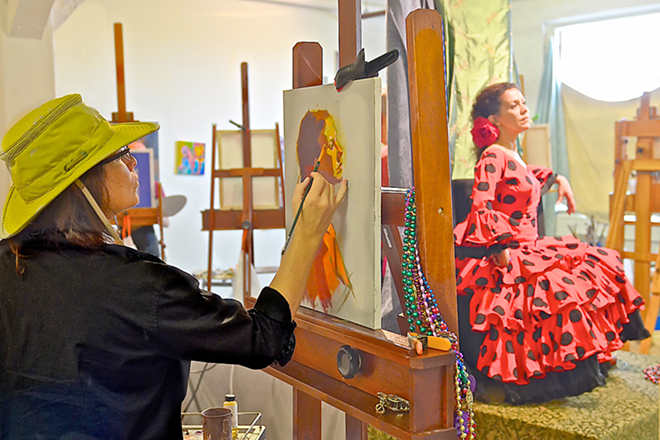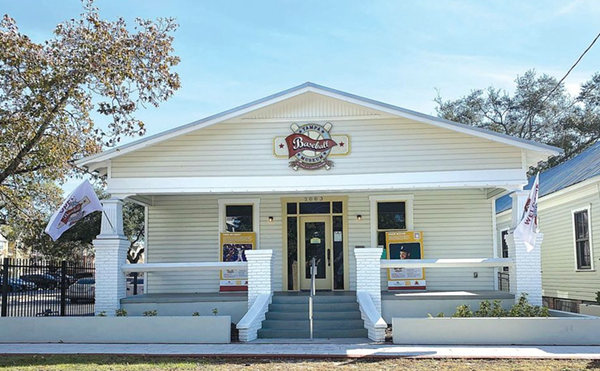
A historic cigar factory in the heart of West Tampa that dozens of artists, as well as a family-owned small business, have called home for 15 years — in theory, it ought to be a shining symbol of the arts in Tampa Bay.
The reality has proven more complicated. On Friday, the former factory’s doors will open to showcase Santaella Studios for the Arts, the latest arts organization to emerge like a phoenix from the conflicting personalities and beliefs that have smoldered, off and on, inside the building for years.
You may remember when the building, located at 1906 N. Armenia Ave. was known as Gallery 1906. Its resident artists drew hundreds of visitors to art parties and open studio events, as memorable for the crowds and lack of air conditioning as the raucous artwork, from the late 1990s to 2006.
Or when, in 2007, the building’s owners and artist Maida Millan, seeking to legitimize the space and secure its future, established a nonprofit exhibition and education center in the building, calling it the West Tampa Center for the Arts.
So what’s Santaella Studios for the Arts?
In a nutshell, the factory’s latest incarnation marks a return of sorts to the Gallery 1906 format — a free-form exhibition by the artists who work in the building’s roughly 30 studios. (Event organizers say virtually every artist in the building is planning to participate.) Veteran talents including painters Alex Espalter-Torres and Lynn Manos, photographic artist Laszlo Horvath and printmaker Debra Radke will be on hand.
But not everyone is happy. The emergence of Santaella Studios as a new entity — the name of which refers to the building’s original identity as the A. Santaella Cigar Factory — has precipitated Millan’s resignation. The former WTCA director and resident artist, who plans to give up the studio she’s kept at the cigar factory for more than a decade on March 1, says the direction in which Santaella Studios seems to be headed is more commercial and less concerned with quality than she would like.
“It wasn’t my vision anymore,” Millan says.
In turn, the artists behind Santaella Studios say the nonprofit WTCA wasn’t serving their interests, which (reasonably) include luring patrons to the building, and that the audience attracted by WTCA exhibits consisted largely of college students drinking beer.
“It’s a down economy,” says Christine Reynolds, a photographer who has kept a studio in the building since 2001. “We wanted to get together and see what we could accomplish as artists.”
Here’s a brief history:
Gray Ellis, patriarch of the Ellis-Van Pelt family that owns the building and the office furniture company in the first floor and basement, recalls that in 1997, shortly after his family purchased the building, an artist approached them about leasing space on the second floor. A mutually beneficial stream of income was born.
By the late ’90s, a critical mass of ambitious artists had moved into the second and third floors, gaga about the factory’s history, high ceilings and huge windows. Many residents, e.g., Millan and painter Guillermo Portieles (who now lives in Miami), had Cuban heritage in common as well as fine art backgrounds. By the mid-2000s, these artists of Gallery 1906 — who also included Espalter-Torres, Horvath and photographer Lori Ballard — were collaborating to throw open studio and exhibition parties that grew steadily until 2006’s Evolución, an exhibition of sculpture, painting, photography and other art that attracted nearly 1,000 visitors.
In 2007, Ellis’s grandson, JD Van Pelt, approached Millan about making Gallery 1906 into a nonprofit; she procured nonprofit status for the new organization, West Tampa Center for the Arts, and became its director. As part of the change, she began implementing a rule that proved unpopular with the studio occupants: it prohibited them from exhibiting art in common spaces during WTCA shows, which typically featured outside artists. A partnership with USF brought student shows to the cigar factory for several years in a row.
Last year, those resident artists began to get other ideas. Led by Kerry Vosler — a traditionally-inclined painter whose studio is home base for her portraiture business and figure drawing classes — many of the artists banded together to re-brand the building as Santaella Studios for the Arts. Vosler says the concept was inspired by the Torpedo Factory in Alexandria, VA, and its mix of artists’ studios and exhibition spaces in an historic building.
For the Santaella group, inclusivity is the bottom line. On Friday, the building’s tenants will let it all hang out, in their studios and on their walls, which means visitors may find, say, printmaker Radke’s subdued compositions of abstract shapes and earthy colors downstairs from photographer Robert Allen Sargent’s glamour shots of local high school girls. Or Lorrie Mason’s silversmithing studio upstairs from a display of Reynolds’ color landscape and wildlife photography printed on canvas.
Inside the large gallery space that is still being called the WTCA, a group exhibition features students from the Art Institute of Tampa. (What happens to the space going forward is up to a board of directors populated by the Ellis-Van Pelt family.) Add to this mix a display of steel horse sculptures by Brooksville-based artist James Oleson and a showcase of models with “art hair,” as advertised on the invite, and you may get an exhilaratingly off-the-wall mix. Or you may get a big mess.
What hangs in the balance is the reputation of a unique arts and business partnership.
“I wouldn’t like to see this place that has such a great location and already has a great track record fall into irrelevancy,” says Espalter-Torres.
I couldn’t agree more.
 That was tasty, but now you need alcohol. Where will you get your drink on?
That was tasty, but now you need alcohol. Where will you get your drink on?















